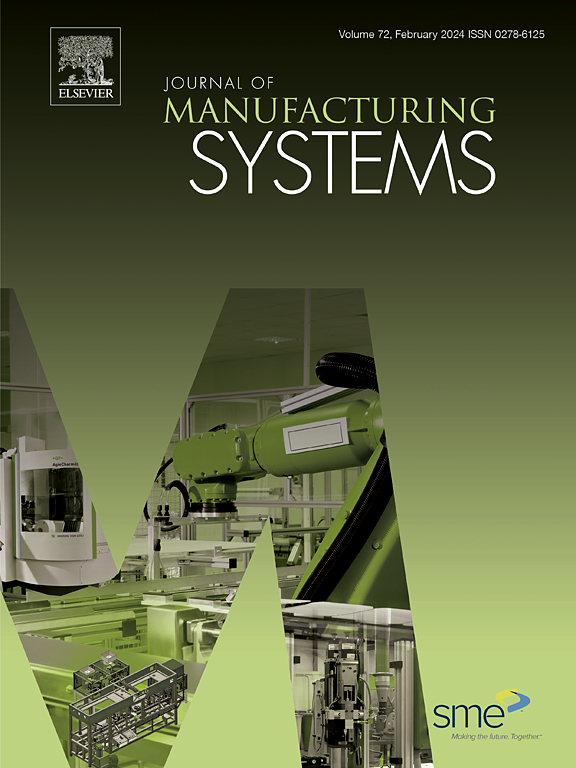Robotic aero-engine pipe grasping posture and motion planning method in multi-stage processing based on multi-objective optimization
IF 14.2
1区 工程技术
Q1 ENGINEERING, INDUSTRIAL
引用次数: 0
Abstract
In the aviation industry, the manufacturing of aero-engine bending pipes consists of multiple processes, e.g., straight pipe bending, allowance removal, precision chamfering, and inspection. Currently, the production of aero-engine bending pipes is carried out mainly manually, and uncontrollable human factors can greatly affect the manufacturing accuracy and efficiency. This paper introduces a grasping posture and motion planning method. It can efficiently and accurately perform multi-stage precision manufacturing tasks on aero-engine bending pipe production lines. First, we provide a gravity deformation model for flexible bending pipes and verify its accuracy through finite element simulations and experiments. It can be used to compensate accurately for the motion of bending pipes entering the processing hole along a straight path. We propose a coordinate transformation method and an accurate calibration method. It can achieve precise transformation of the original posture of the computer-aided design (CAD) model and the postures at the processing stations, e.g., the outlet of the clamping mold of the bending machine, the processing holes of the residual removal and the flat end chamfer. Next, we propose converting the linear paths into NURBS interpolation paths and using the S-shaped acceleration/deceleration (ACC/DEC) feed rate planning method. It can convert the velocity, acceleration, and jerk into the corresponding angular velocity, acceleration, and jerk of each joint in the joint space to ensure that processing and inspection tasks can be performed under appropriate kinematic constraints. Then, an improved NSGA-II algorithm is proposed, which can solve the trade-off minimization problem of processing time, energy consumption, and vibration by incorporating multi-objective optimization functions and motion constraints. The simulation and experimental results demonstrated the superiority of optimization method in terms of processing accuracy, precision, stability, and efficiency. The performance of the improved NSGA-II algorithm is compared with that of other multi-objective optimization algorithms, and the superior performance of the algorithm is verified.
基于多目标优化的多阶段加工机器人航空发动机管道抓取姿态及运动规划方法
在航空工业中,航空发动机弯曲管的制造包括多个过程,例如直管弯曲,余量去除,精密倒角和检查。目前,航空发动机弯管的生产主要是手工进行的,不可控的人为因素会极大地影响制造精度和效率。本文介绍了一种抓取姿态和运动规划方法。它能在航空发动机弯管生产线上高效、准确地完成多阶段精密制造任务。首先,建立了柔性弯曲管的重力变形模型,并通过有限元仿真和实验验证了模型的准确性。它可以精确地补偿弯曲管沿直线路径进入加工孔的运动。提出了一种坐标变换方法和精确标定方法。它可以实现计算机辅助设计(CAD)模型的原始姿态与折弯机夹模出口、残件去除加工孔、平端倒角等加工工位的精确转换。接下来,我们提出将线性路径转换为NURBS插补路径,并采用s型加减速(ACC/DEC)进给速度规划方法。它可以将速度、加速度、加速度转化为关节空间中各个关节对应的角速度、加速度、加速度,以保证在适当的运动学约束下完成加工和检测任务。然后,提出了一种改进的NSGA-II算法,该算法通过引入多目标优化函数和运动约束,解决了加工时间、能耗和振动的权衡最小化问题。仿真和实验结果表明,该优化方法在加工精度、精度、稳定性和效率等方面具有优越性。将改进的NSGA-II算法的性能与其他多目标优化算法进行了比较,验证了算法的优越性能。
本文章由计算机程序翻译,如有差异,请以英文原文为准。
求助全文
约1分钟内获得全文
求助全文
来源期刊

Journal of Manufacturing Systems
工程技术-工程:工业
CiteScore
23.30
自引率
13.20%
发文量
216
审稿时长
25 days
期刊介绍:
The Journal of Manufacturing Systems is dedicated to showcasing cutting-edge fundamental and applied research in manufacturing at the systems level. Encompassing products, equipment, people, information, control, and support functions, manufacturing systems play a pivotal role in the economical and competitive development, production, delivery, and total lifecycle of products, meeting market and societal needs.
With a commitment to publishing archival scholarly literature, the journal strives to advance the state of the art in manufacturing systems and foster innovation in crafting efficient, robust, and sustainable manufacturing systems. The focus extends from equipment-level considerations to the broader scope of the extended enterprise. The Journal welcomes research addressing challenges across various scales, including nano, micro, and macro-scale manufacturing, and spanning diverse sectors such as aerospace, automotive, energy, and medical device manufacturing.
 求助内容:
求助内容: 应助结果提醒方式:
应助结果提醒方式:


